(→Design) Tag: Visual edit |
No edit summary Tag: Visual edit |
||
| Line 149: | Line 149: | ||
* '''''Merchandising: '''''[[Diane Flynn]] |
* '''''Merchandising: '''''[[Diane Flynn]] |
||
* '''''Merchandising Asst. '''''[[Ray Paulsen]], [[Sally Lewis]], Gary Mikialian, Nancy Baddock & Louise Koskella |
* '''''Merchandising Asst. '''''[[Ray Paulsen]], [[Sally Lewis]], Gary Mikialian, Nancy Baddock & Louise Koskella |
||
| + | |||
| + | == Quotes == |
||
| + | <blockquote>''The Residents have been in San Francisco making records for about 12 years, but they've never performed until now. A couple of reasons behind that. There was a synthesizer invented called the [[Emulator]], which was invented a couple of years ago and allowed The Residents to perform all of their music live. Until now, they had not been able to do that because the music is very difficult to do live. They had been very used to the studio. I also believe they were just ready for a little trip out of San Francisco to go to Europe to see things they'd never seen before.''</blockquote>- [[Nessie Lessons]], [https://www.youtube.com/watch?v=B3sEgtM8oKI&list=PLzArvRO4RQowDan-DZGDgaOQgjSeqRsBj&index=9 Mole Show interview,] 1983 |
||
== Related releases == |
== Related releases == |
||
Revision as of 23:22, 20 January 2022
| This article is about the live tour. You may be looking for the 1983 live album, 1984 video, or 2009 DVD bag set of the same name. |
The Mole Show (often stylized Mole Show or Moleshow) was the first tour by The Residents, officially debuting in October 1982 and continuing until July 1983.
The Mole Show was designed to showcase the plot of the first two albums of The Mole Trilogy, but was ultimately a financial disaster for the group and resulted in the partial splintering of The Cryptic Corporation and the premature (and to date permanent) abandonment of the Mole Trilogy in 1985.
History
Conception
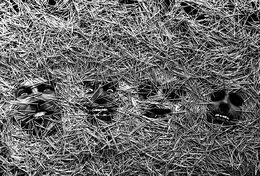
The Residents, 1982
After a decade of making music together under the name The Residents and only performing live on one occasion in 1976, the group decided to undertake their first tour as a means of dealing with a number of tensions and conflicts that had arisen between the group's members.
The Residents had previously avoided touring or undertaking any serious live performances because their music depended largely on the studio, and the group feared that it would not translate well to stage. Their previous live performances in 1971 and 1976 only seemed to reinforce this notion.
In 1981, the EM-U Emulator was released. The first widely-adopted sampler, the Emulator was a big step forward in electronic music, allowing musicians to reproduce virtually any sound with great precision and control. The Residents began using the Emulator on their 1982 album The Tunes of Two Cities (the second release in their ongoing Mole Trilogy), and realized that the increased freedom the instrument allowed them would remedy a number of the issues they had previously faced in performing live.
The Residents wanted to tour, but they knew that they didn't want to do a standard "rock band" concert. They wanted to produce something more theatrical, and considered producing an opera, a concept which they had been toying with since the development of Not Available in 1974. They also considered revisiting their abandoned attempt to perform the Eskimo album in a series of live performances.
In 1982, the group briefly developed and rehearsed a retrospective "10th Anniversary Show", which was later abandoned (although live studio rehearsals of songs intended for the set list of this unproduced show can be heard on Assorted Secrets and other archival releases). Ultimately, The Residents decided to develop a show based on their current project The Mole Trilogy, composed at that time of 1981's Mark of the Mole, and The Tunes of Two Cities.
These two albums became the basisl for the new show: Mark of the Mole gave the show a plot, and The Tunes of Two Cities provided linking music between "scenes". The Residents also composed and recorded new music for the show, to be included as thematically relevant pre-recorded music to be played during the pre-show, intermission, and after-show; these pieces of music were released in 1982 on the EP Intermission.
Design
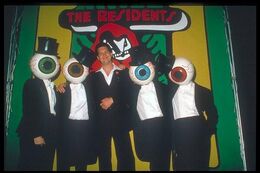
The Residents with Penn Jillette, 1983
With a second Emulator and help from EM-U, The Residents began putting together The Mole Show. The successes they had been having with sales meant that The Cryptic Corporation and Ralph Records had grossed about half a million dollars in their eight-year history.
With the capital from the company and the expectation that the tour would pay for itself, The Residents went all out with the production of the show. The band attempted to hire Graeme Whifler, who had worked with them on their abandoned feature film Vileness Fats and a number of their music videos, to direct the show. Whifler, who had never directed a live performance, declined the offer.
The set consisted of huge 21' x 18' backdrops flanking a burlap scrim, behind which The Residents played. The Residents hired Kathleen French to do the choreography and Phil Perkins to design the lighting. The characters from the Mole Trilogy (the Moles and the Chubs) were represented by cut-out figures which were manipulated by stage hands in modified Groucho Marx glasses (with the nostrils removed from the nose, and the moustaches attached to the tip of the nose to allow the wearers to breathe while also preserving their anonymity).[1]
These modified Groucho glasses were also worn by The Residents for much of the performance; the members of the group signed around 75 of the glasses, originally intending to remove them at the end of the performance and throw them into the audience. In the end only one member of the group threw a single pair of the glasses into the audience, and the remaining signed glasses were later sold to fans through mail order by Ralph.[1]
The group hired Penn Jillette, their friend and collaborator on the recent Ralph Records 10th Anniversary Radio Special!, to appear onstage as narrator, providing linking segments to help convey the storyline of the performance. Perkins illuminated the stage from below and behind and used only one spotlight, trained on Jillette, who would come on between numbers to explain what was happening to the audience, usually in an intentionally patronizing and insulting manner.
Early performances
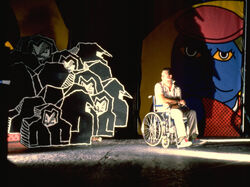
Penn Jillette gagged in a wheelchair, 1982
The first performance of The Mole Show was a warm-up at The House in Santa Monica on April 10th, 1982, in front of an audience of sixty people. This was a music-only performance of the show - no dancers, narrator, or sets - to make sure that the Emulators were up to the task. The official opening of the tour was on October 26th at the Kabuki Theatre in San Francisco. The Residents had two sold-out shows there, then moved on for four shows in Los Angeles and one in Pasadena.
The shows were generally well received, though the audiences didn't always know what to make of them. Towards the end of the show the emcee Penn Jillette, having taken pot-shots at the primitive effects and strange story throughout the show, would (apparently) lose his temper, yelling at the performers and storming offstage. After a brief pause, Jillette was then brought back onto the stage gagged, tied to a wheelchair, and wearing Groucho glasses.
In spite of the seemingly confusing narrative, The Mole Show was initially a success for the group. The only technical problem at first up was overheating in the Emulator disc drives due to the eighty-five disc changes necessary in the show, but this was minor in comparison to the trouble they previously experienced trying to emulate their studio sound during previous attempts at live performance. Confident after the successful shows in California and reassured by their new business manager Bill Gerber (who had worked with Devo), The Residents were set to take the show to Europe.
Disasters
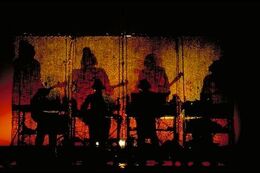
The Residents in The Mole Show
In July, Jay Clem (the business manager and co-founder of The Cryptic Corporation) left the company. He was apparently dissatisfied with the independent music business and went on to establish his own management company. Then, after the Kabuki Theatre shows, the president of The Cryptic Corporation, John Kennedy, announced that he, too, was leaving. He grown tired of pumping money into the group, and the expense of staging The Mole Show was the last straw. To make things worse, he took The Residents' Grove Street studio with him. The entire production ground to a halt, and it was only with the help of friends and family that the tour could continue.
However, another problem came up when the band were preparing to take the show to Europe. The sets were so huge that only a 747 jet could carry them across the Atlantic, causing the struggling group a huge expense. Then, with about twenty people to lodge and feed as they traveled, costs started climbing (they even reduced the number of dancers from four to three to try to cut costs). In order to raise funds ahead of time, the band had sold the merchandising rights for $10,000. At their shows, the merchandise sold well, making far more money than The Residents ever got out of the tour. This decision cut deeply into the tour's ability to pay for itself.
The performances themselves went very well, becoming a critical success and selling out all over Europe. However, the English road crew the band had hired didn't like having to wear the Groucho glasses, and they didn't get along at all with Jillette, who is very strongly anti-smoking, anti-drink, and anti-drugs. In the end, the group had to segregate the buses, with the roadies in the "Party Bus" and Jillette in the "Library Bus".
There were also the usual accidents and thefts one suffers when touring, but the band hadn't allowed for these, and had no leeway in their plans to cope with them. Other problems included Jillette being hospitalised just before a show in Spain with some sort of stomach problem (the group had to get their stage manager to cover the narration for that performance) and, on another occasion, Jillette was attacked on stage by an irate member of the audience while he was tied to the wheelchair.
The Uncle Sam Mole Show
All in all, the Mole Show tour was a nightmare for The Residents. After the last show at Leicester Polytechnic on July 1st 1983, the group vowed never to tour again. They had lost so much money that Ralph Records was in danger of going under, and the group was rescued at the last minute only by an invitation to perform one final Mole Show performance as the opening show of the November New Music America Festival in Washington D.C. At first they refused, but ultimately couldn't afford to pass up the money offered.
Unfortunately, the nightmare wasn't over yet. Their tour manager had failed to pay the English shipping agent, who was holding all of their sets and instruments in England until they could pay $16,000 for their return. The group convinced the shipping agent to take $10,000 up front and the balance after the festival, but even when they paid that cash to the shipping agent, he kept holding out for the balance without sending the gear.
The Residents ended up arriving in Washington without anything, and had to rebuild all of the backdrops and sets from scratch. They hired dancers from a local ballet school, begged an Emulator from EM-U, and had to convince their manager to do the narration because Penn Jillette couldn't make it - all in the last two weeks before the show. They rehearsed at the local YMCA and the dress rehearsal went so badly that they couldn't complete it. Finally, to add insult to injury, the missing equipment showed up from England just hours before showtime, after Gerber had threatened the shipper.
In spite of every indication that it would be as big a disaster as the tour had been, the "Uncle Sam Mole Show" performance was possibly the best performance of the entire tour. The long-unreleased recording of this show features as the fourth disc of the 2019 pREServed six disc collection Mole Box.
End of The Mole Trilogy
After the Uncle Sam Mole Show performance, The Residents left the Mole Trilogy behind temporarily. The project was initially intended in part to help deal with frustrations the group were experiencing, but ended up being far more frustrating than the original problems had been. The whole project had been an amazing critical success - the costumes and sets became part of the permanent collection at the Los Angeles Museum of Contemporary Art after the tour - but financially the group were nearly ruined.
The Residents eventually returned to The Mole Trilogy in 1985 with the fourth part of the series, The Big Bubble, but the trilogy was to be left incomplete with no further albums following this release. Despite their vow never to tour again, The Residents eventually followed The Mole Show with their second tour, The 13th Anniversary Show, in 1985. This tour was a far more successful operation which led the group to continue touring regularly for the course of their career.
Performances
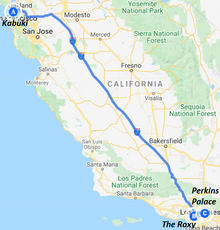
A map of the group's stops on the first leg of the tour
First leg
- 10th April 1982 - The House, Santa Monica (music-only performance)
- 26th October 1982 - Kabuki, San Francisco
- 27th October 1982 - Kabuki, San Francisco
- 29th October 1982 - The Roxy, Los Angeles (two shows)
- 30th October 1982 - The Roxy, Los Angeles (two shows)
- 31st October 1982 - Perkins Palace, Pasadena
Second leg
- 23rd May 1983 - Rotation, Hannover
- 25th May 1983 - Succession, Vienna
- 26th May 1983 - Succession, Vienna
- 27th May 1983 - Alabamahalle, Munich
- 28th May 1983 - Volksbildungsheim, Frankfurt
- 29th May 1983 - Schumannsaal, Dusseldorf
- 30th May 1983 - Metropol, Berlin
- 1st June 1983 - Falkoner Theatre, Copenhagen
- 2nd June 1983 - Markthalle, Hamburg
- 3rd June 1983 - Zeche, Bochum
- 5th June 1983 - Plan K, Brussels
- 6th June 1983 - Muziekcentrum, Utrecht
- 7th June 1983 - L'Olympia, Paris
- 8th June 1983 - Palais D'Hiver, Lyon
- 9th June 1983 - Volkhaus, Zurich
- 12th June 1983 - TeatroTenda, Bologna
- 13th June 1983 - The Rolling Stone, Milan
- 14th June 1983 - Teatro Apollo, Firenze
- 17th June 1983 - Salon Cibeles, Barcelona
- 18th June 1983 - Sala Extases, Valencia
- 19th June 1983 - Rock Ola, Madrid
- 20th June 1983 - Rock Ola, Madrid
- 21st June 1983 - Le Edad De Oro, Madrid
- 23rd June 1983 - Cinéma Le Fémina, Bordeaux
- 24th June 1983 - Théâtre Municipal, Poitiers
- 27th June 1983 - Town Hall, Birmingham
- 28th June 1983 - Hammersmith Odeon, London
- 29th June 1983 - Royal Court, Liverpool
- 30th June 1983 - Queens Hall, Edinburgh
- 1st July 1983 - Leicester Polytechnic, Leicestershire
- 7th October 1983 - New Music Festival ("Uncle Sam Mole Show"), Washington
Set list
- Voices of the Air
- The Secret Seed
- The Ultimate Disaster
- God of Darkness
- Migration
- Smack Your Lips (Clap Your Teeth)
- Another Land
- The New Machine
- Song of the Wild
- Final Confrontation
- Satisfaction
- Happy Home
Credits
Taken from the Mole Show LP inner sleeve.
- Written & Directed by: The Residents
- Music Written & Played by: The Residents
- Narrator: Penn Jillette
- Dancers: Kathleen French, Carol Werner LeMaitre, Sarah McLennan Walker & Chris Van Ralte
- Vocalist: Nessie Lessons
- Sound: Scott Fraser
- Lighting Designer: Philip Perkins
- Lighting Director: Dan Gillham
- Stage Manager: Laurence Campling
- Backdrop Movers: Raoul N.D Seimbote & Eric Knorr
- Artistic Direction: The Residents
- Sets & Props: Laurence Campling, Leigh Barbier, Homer Flynn & Hardy Fox.
- Costumes: Sheenah Timony
- Tour Manager: Paul Young
- Publicist: Mara Mikialian
- Manager: Bill Gerber/Lookout Management
- Legal Matters: Evan Medow
- Business: Siegel & Feldstein
- Security: Thomas Timony
- Merchandising: Diane Flynn
- Merchandising Asst. Ray Paulsen, Sally Lewis, Gary Mikialian, Nancy Baddock & Louise Koskella
Quotes
The Residents have been in San Francisco making records for about 12 years, but they've never performed until now. A couple of reasons behind that. There was a synthesizer invented called the Emulator, which was invented a couple of years ago and allowed The Residents to perform all of their music live. Until now, they had not been able to do that because the music is very difficult to do live. They had been very used to the studio. I also believe they were just ready for a little trip out of San Francisco to go to Europe to see things they'd never seen before.
- Nessie Lessons, Mole Show interview, 1983
Related releases
- Mark of the Mole (1981)
- The Tunes of Two Cities (1982)
- Intermission: Extraneous Music From The Residents' Mole Show EP (1982)
- Mole Show (Live At The Roxy) (1983)
- Mole Show/Whatever Happened To Vileness Fats? VHS (1984)
- Assorted Secrets (1984)
- PAL TV LP (1985)
- Mole Show: Live In Holland (1989)
- Mole Show limited CD+DVD set (2009)
- Mole Box pREServed six disc set (2019)
See also
External links and references
- The Mole Show on The Residents Historical
- The Mole Show on RZWeb
- The Mole Show Live in Madrid, June 21st 1983 on YouTube (complete performance)
- ↑ 1.0 1.1 Post by Kim Andrews, The Residents unofficial Facebook group, December 31st 2021
